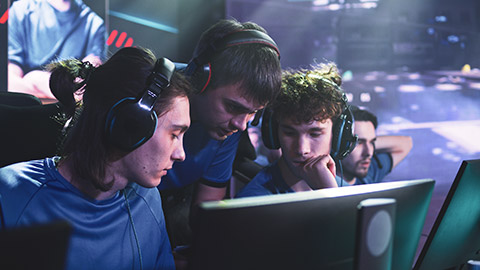What is Leadership?
I start with the premise that the function of leadership is to produce more leaders, not more followersRalph Nader
Leaders are not born, leaders are made. Every good leader in history has a great leader as an example, a guide, a mentor. This could be friends, family, co-workers or even strangers that inspire us to be better. A true leader will always see everyone as equals, believing in them, rescuing potential and empowering people so they not only learn but surpass.
Let’s meet Dan…

Dan plays TFT and has climbed the ranks. Throughout his climb he has regularly played with multiple top players from the region and gotten to know them well. With that, they begin calling on discord and watching each other play and talk about different strategies. The four of them decide to create what is called a "study group" in order to make the push to dominate competitive TFT. Although TFT is usually an individual game, a 4v4 tournament is announced where the scores of each individual are added up and the team with the most points after the game wins. They decide to sign up and play vs other top teams from around the world. Dan quickly takes the lead when it comes to practice.
- Leading a team to achieve team goals
- Setting goals, accountability and allocating tasks
- Having a contingency plan
- Communicating goals to the team
- Creating an environment of communication and collaboration
- Coaching and mentoring team by Identifying learning and development opportunities
- Resolving conflict and providing feedback in a positive way
This module will teach Dan the skills and knowledge that enable him to perform his role. In a nutshell, these fall into the 4 following skill sets:
- Plan team outcomes
- Coordinate team and individuals
- Support team
- Monitor team performance
To begin, let's have a chat with Dan about his role.
In your opinion, what are some of the skills required to effectively lead and facilitate a team?
In my opinion, some of the key skills required to lead and facilitate a team is building a cooperative and strong relationship with team members. It is important to establish clear and consistent communication through active listening and using verbal, nonverbal and written communication techniques. Motivating the team and building self-esteem builds on confidence and produces successful outcomes. Recognise and acknowledge the hard work of the team, managing conflicts effectively, delegating the work appropriately and fairly. It is important to provide clear feedback to the team members and mentoring them when required.
How would you delegate responsibilities to your team?
Firstly, I will make sure that I review the tournament or task requirements and the time frame for completion. I would then choose the right person from the team to delegate the roles of the tasks to; knowing the team well and their strengths is key here. I would explain to the individual the reason for delegating the tasks and provide the correct instructions, resources, and tools to them. I will support them if any conflict arises and provide feedback as and when required, and after the tasks, I will acknowledge the hard work put in by the team member.
What skills are essential for training and coaching team members?
I believe the most important skills for training and coaching are to:
- work together with teammates to develop ideas and implement plans collaboratively,
- know the strengths of the team members and consistently build on their work from those strengths, carefully manage the reactions of the team members to stressful situations,
- demonstrate genuine concern for their wellbeing and life outside of TFT.
- recognising the hard work everyone has put in, that way everyone will get the opportunity to feel valued and appreciated
The Concept of Leadership
So, what is leadership and why is it important to you? Well, by definition, leadership is leading a group of people, but it is much more than that. There are so many ways to lead, and there is no exact way to being a leader. There are, however, qualities that leaders have, and the focus of this topic will be to develop these qualities so that you can excel not only in eSports but in everyday life too. Leadership in eSports can be shown in various roles, whether it be within a team competing, coaching, setting up events and many more.
Watch the following video about leadership. This is how leadership is viewed not only in business but in the eSports industry as well. Take notes of what leadership is and how its measured.
Watch: Leadership Explained in 5 minutes by Simon Sinek (5:24 minutes)
Using what you learned from the video, what are three ways you can show the qualities of a great leader in your everyday life?
Based on the video, Sinek states that people respond better to leaders they can trust. Trust needs to be built over time and is a process not to be rushed.
A Leader online can become a leader in real life (IRL).
Let’s face it. We are all different, and that’s good. We were all blessed with a different set of skills. Leadership is not necessarily about displaying confidence when you know you will do a good job. Sometimes leadership is uncertainty, sometimes leadership is taking the responsibility when no one else wants it.
In eSports, like in real life (IRL), most people confuse a position of power with leadership. A leader could be part of the team without occupying any position of power. That been said, a captain is usually appointed by the entire team (players and staff) because it’s the most complete player. A captain must be talented inside of the game, mature and reliable with his teammates and the org. There is power given to the captain and they will become the voice of the team outside, and sometimes inside (shot caller), of the game.
There is a downside of having this power, however. People who are not leaders tend to become just bosses when given power to them. Here are a couple of differences between a boss and a leader:
| Differences between a boss and a leader | |
|---|---|
| Boss | Leader |
|
|
Portfolio checkpoint: 4A: Defeating the Boss!
Using the comparative chart that differentiates a boss from a leader:
- Select five characteristics or conducts of a boss that can be displayed in eSports
- Select five characteristics or conducts of a Leader that can be displayed in eSports
Boss Characteristics:
- Characteristic 1:
- Example of C1:
- Characteristic 2:
- Example of Characteristic 2:
- Characteristic 3:
- Example of C3:
- Characteristic 4:
- Example of C4:
- Characteristic 5:
- Example of C5:
Leader Characteristics:
- Characteristic 1:
- Example of C1:
- Characteristic 2:
- Example of Characteristic 2:
- Characteristic 3:
- Example of C3:
- Characteristic 4:
- Example of C4:
- Characteristic 5:
- Example of C5:
Add this to your portfolio.
As you know, being a leader in eSports is more than just being an in-game leader. Some of you may wish to be in roles where you lead within an organisation. Your organisation will have several requirements that you must meet to be an effective leader in your workplace. These requirements will guide and help you to demonstrate the kind of leadership that your organisation needs.
Every organisation has its own set of values and culture and policies and procedures. As a leader in your workplace, you must be able to identify them before you can exhibit them. To identify them, you must first understand what they are.
The following sections will explain organisation values, culture, code of conduct, policies, and legislation in a workplace.
Organisational values and Culture
Every organisation has a set of principles that it will follow. Organisational values are important in developing the workplace culture and the organisation’s reputation to those outside of it.
An organisation’s values are based on what kind of organisation it is. For example, consider the values and guidance contained in the mission statement from well-known merchandiser, L.L. Bean: Sell good merchandise at a reasonable profit, treat your customers like human beings, and they will always come back for more. The statement establishes a clear priority for dealing with customers when they are shopping for or reporting a problem with a company product.
Impact on teamwork
These principles and ethics then guide the behaviour of organisation members. They assist organisations in determining what is right and wrong. Members then act in certain ways, using the values as a guide. For example, an international university would have academic excellence and diversity values, while a construction company would prefer safety and professionalism. It is essential for you to know and understand your organisation’s values because it will guide you towards the kind of performance that truly represents it.
Values
Organisational values are usually subject to change because as a company changes, so does its values. The values will always reflect what an organisation strives to present in all its procedures, projects, and output.
Code of Conduct
Purpose of the Code of Conduct- It is designed to outline the standard of behaviour expected by employees of an organisation. Each and every organisation will have the core ethical behaviour and code of conduct that all staff are expected to adhere to and must follow.
Impact on teamwork:
Having a code of conduct can give employees a structure to follow from the moment they join the company, reducing the chances of problems coming up and making the process of dealing with issues a lot easier should the worst occur.
Following are some of the most common code of conduct principles that most workplaces and organisations would adhere to:
- be inclusive: ensure that all internal and external customers are treated the same
- be honest: ensure that you in business representations with internal and external customers
- be accountable: promise what you say you will deliver
- be sustainable: ensure that sustainability plays an important part in any work activities that you undertake
- be professional: ensure that you act with integrity at all times.
Anti-discrimination policy and legislation
- In any workplace, discrimination and harassment are not tolerated. Workers should be treated fairly and should be given equal opportunities in the workplace.
- Most workplaces include anti-discrimination policies, and it is important to be aware of what they include.
- Unlawful workplace discrimination can occur when choosing who to employ or promote. Discrimination can also occur by favouring one employee over another on the basis of race, colour, sex, sexual orientation, age, disability, marital status, carer responsibilities, pregnancy, religion, political opinion or national origin.
- This video explains what is considered discrimination in the workplace:
Leadership roles in eSports events include:
- Event Producer
- Event Director
- Team Owner
- Social Media Manager
- Headhunter
Different methods of communication
| Method | Explaination | Examples of Effective Use |
|---|---|---|
| Verbal | Verbal interactions include: the use of voice and spoken words either face to face or telephone using pitch and tone of voice to indicate depth and further meaning to the words used. |
Effective use of verbal communication includes: face-to-face situation such a meeting or feedback when clarification is required and complex information needs to be explained when communicating on a personal level or in a conflict or negation situation. |
| Non-Verbal | Non-verbal interactions include: using body language, facial expression, sounds indicating active listening and supporting a congruent message using sign language in an environment when it’s difficult to hear the spoken word. |
Non-verbal communication supports verbal communication and infers deeper meaning of congruity and/or emphasis. This is effective in coaching session, negotiations and conflict situations. It is used with all visual interaction and communication. It is also used in noisy workplaces or communicating with a deaf or hard-of-hearing person. |
| Written | Using the written communication is important to maintain a record of any interaction. This can be by an electronic form or hard copy, such as email, letter, instant message, text, etc. | Effective use of written communication includes:
|

In eSports, the coordination of the team and players can be a huge pillar of strength within a team. Being able to both enable but also drive coordination within your team whether it be as a player or as a coach is huge when it comes to contributing to the overall success of the team.
Now, there are many strategies that leaders can implement to drive effective team coordination. These include things like allocating responsibilities and accountability for the tasks, creating an environment that fosters collaboration, using effective communication techniques and providing direction and support to the team to achieve the goals effectively and efficiently. Here are some of the techniques commonly used by Leaders for team coordination:
- Teamwork: This one may seem straightforward, but working in a team is essential for coordinating that team. Leaders skilled in teamwork can adequately delegate work to their team members, ensuring that no one has too much or too little to do. Also, a leader who focuses on teamwork is a leader who can easily motivate their team to provide their best work. Instead of being a boss who gives orders, they demonstrate that they are just as much a part of the team and genuinely care about their team members' progress. Teamwork allows a leader to feel more connected to their team and encourages the growth of a ‘work together environment,’ leading to increased productivity and happier work life.
- Fostering great communication: A strong leader can clearly and concisely communicate goals, tasks and other organisational needs to their team. Leaders should be masters in written and verbal communication to ensure expectations are presented to their employees in a way they can understand. Being an effective communicator also involves listening intently, speaking clearly, understanding body language and being conscious of your tone.
- Creating well–defined roles and empowering the team members: Being a good leader means knowing which of your team members are best suited to take on a project or task and empowering them to do so. Delegating tasks to other team members is an opportunity to showcase their skills while learning new ones, and makes them feel more committed to their work.
- Sound planning and goal setting: The success of any team is often dependent on the team leader. Goal setting allows the team to work towards something and inspires team-work and innovation. Once the goals are set it is time to plan the execution of the goals along with plan for any contingency and problems that may arise along the way.
As leader of your team, you will be required to allocate tasks to team members. This is not as simple as dividing the tasks equally between individuals, as it is important to encourage people to take on work they are good at and also feel excited by. Allocating tasks fairly as opposed to equally will help everyone feel they are contributing and enjoying their work. This is a particularly important skill as a coach or as a leader within one of the more commercial roles within eSports.
- Priority—This should be your first consideration when you distribute work and your priority list should be reviewed often. If a project is the first priority and someone is available and able to do it, then they can be given the task.
- Skill Sets— You don’t want to be giving someone a role they cannot fulfil to the level of expectations you have. Understanding your team's individual skill sets and capabilities will help allocate tasks to those who are best suited to the work.
- Availability—Who is available to do the work? Once the priority and skill sets are determined, your next question is, who actually has the time to complete the task? This is particularly important if you consider shifting someone from a project onto new work when there are other team members available and capable of doing the work. There may be frustration among other people working on the original project, and others who feel they could have done.
- Development—As a leader, ensuring team members have development opportunities is a great way to grow their capabilities. With the right guidance, feedback and coaching, you can help lift your team member or player into the next level of performance.
- Interest—The final consideration when allocating tasks is who has a particular interest in the work needed. Allocating work that your team are passionate about can help achieve great results, so it can be helpful to create a balance between development opportunities and working on tasks of interest.the work just as well.

As a leader, you will come up against challenges at some stage. You will be required to help your team resolve challenges related to tasks or conflicts within the team.
Task-Related Challenges
Task-related challenges are issues that arise about the work that needs to be completed. They are often specific and impact the efficiency or quality of someone’s work. These challenges may be restricted to one team member or be experienced by the team as a whole. Rather than taking all challenges on board yourself, a good leader will include their team in the process to develop the skills of their employees. Some examples of determining the way out of a task-related challenge include bringing the team together for a brainstorming session, engaging experts external to your organisation, working with other departments or teams, and facilitating a GROW coaching session with the team member or broader team.
Team Conflict
Conflict within your team can be harder to identify and address. What examples of conflict in the workplace have you experienced or witnessed? Do you feel the conflict was dealt with appropriately?
If your organisation has a Conflict Resolution policy and procedures, it is helpful to be aware of what these entail and access them easily. These are designed to help resolve a complaint or conflict quickly and fairly in a consistent manner with the organisation’s values. When attempting to resolve conflict within a team, you first need to understand the cause of the conflict, and then arrange a meeting with the relevant team members.
Strategies for conflict resolution and negotiation:
- Clarify what the disagreement is—Continue to ask questions until you are satisfied you understand what the disagreement is about. Sometimes parties see the disagreement differently, so it is important to understand how each team member views the issue.
- Establish and negotiate a common goal for all parties—Establish what each team member would like to see happen. If both sides agree on a common goal, they are more likely to work through the required changes or process to reach it. Continue asking questions until all parties can agree on an outcome.
- Discuss ways to meet the common goal—Ask what problems may prevent a resolution and discuss these as a team. By understanding what problems may be, you can find solutions.
- Determine barriers to the common goal—Understanding possible problems that can occur is important so a resolution can be found. It is important for everyone to understand what can and cannot be changed and work around fixed issues.
- Agree on the best way to resolve conflict—Everyone needs to agree on the best solution. Begin by asking each person what they consider common ground. This can help to find a solution that everyone can live with. This also leads to a discussion about responsibilities in maintaining the solution, and understanding how the conflict came about so it doe Everybody needs to get to
- Acknowledge the agreed solution and responsibility - the point where they own their responsibility in resolving the conflict. Having all involved express what they have agreed to is important to be confident that everyone is on the same page and understands what is to happen moving forward. Following up with an email outlining these responsibilities can be helpful to ensure once again these are clear to all.
